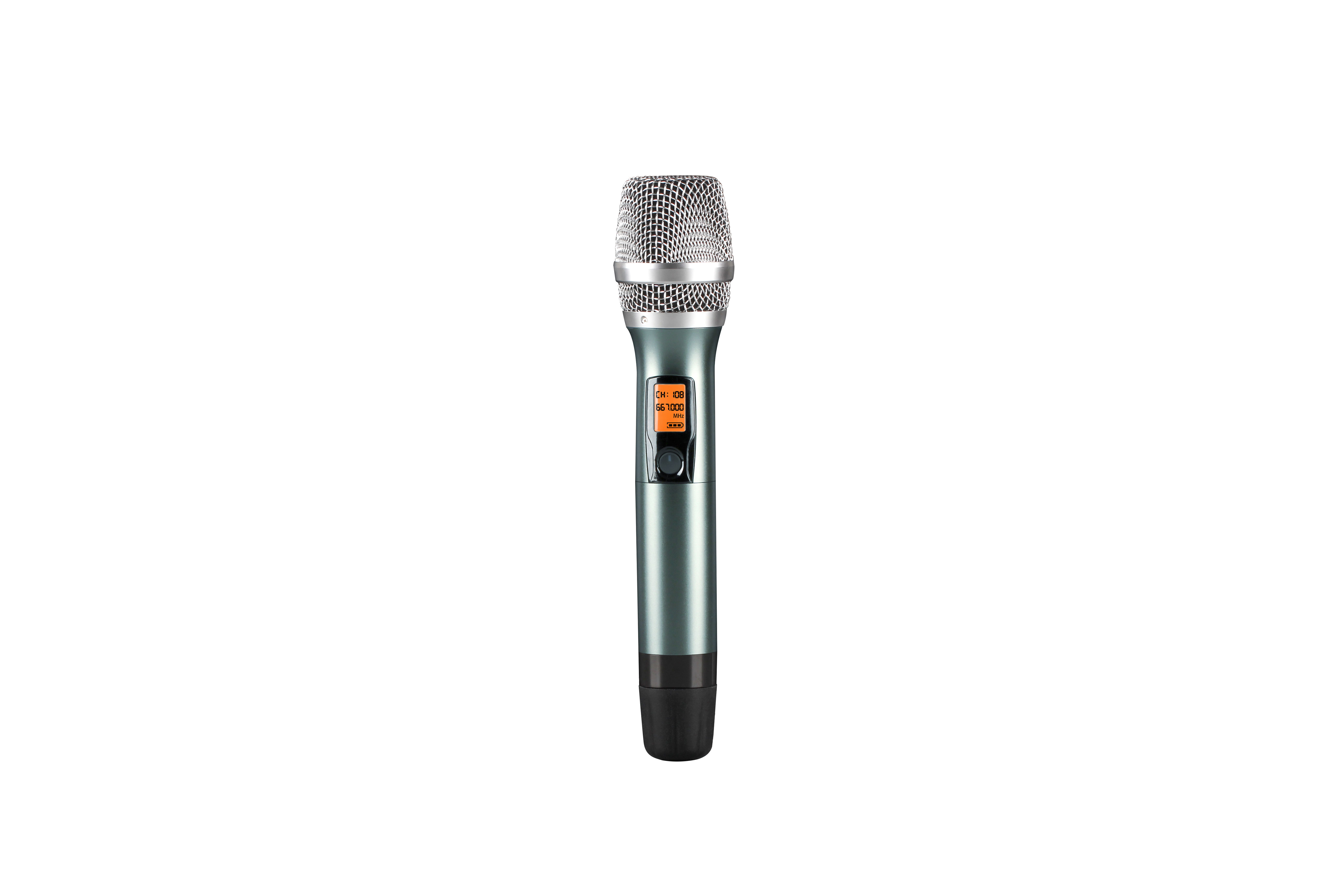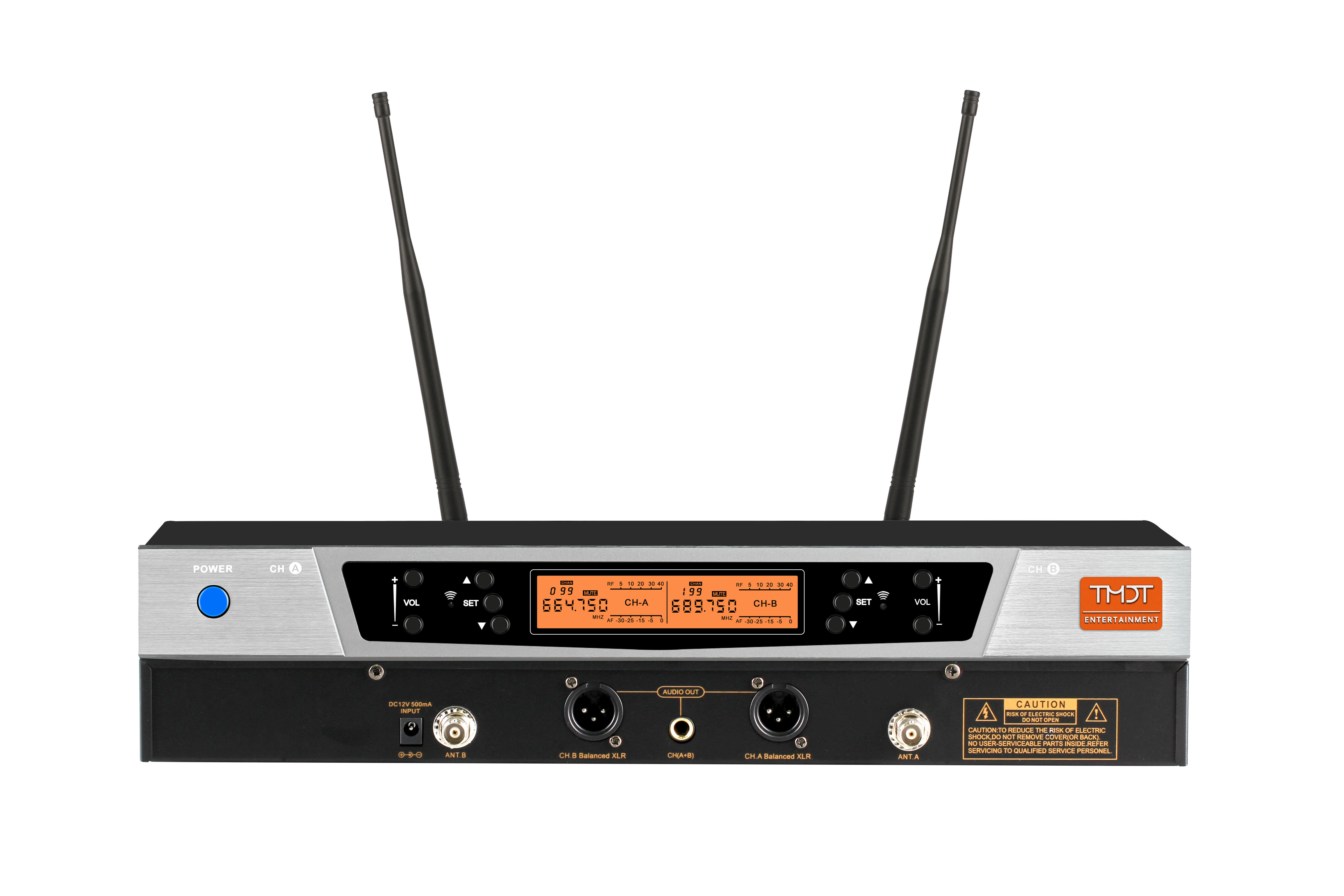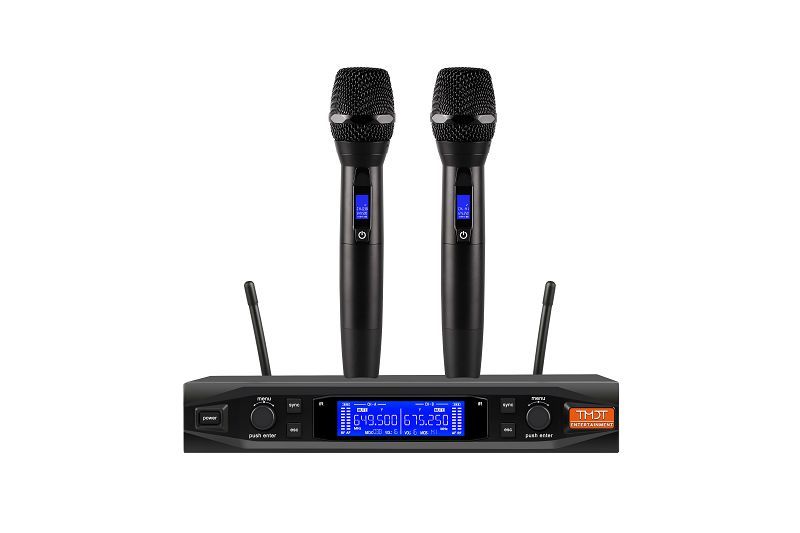




K7
Featuring a stable output, the Sweet K-Series wireless system is easy to set up and intuitive to display, allowing for tailor-made sound solutions for a wide range of entertainment applications.
Category:
- Details
- Function
- Solution
- Parameter
-
- Commodity name: K7
Featuring a stable output, the Sweet K-Series wireless system is easy to set up and intuitive to display, allowing for tailor-made sound solutions for a wide range of entertainment applications.
The product is suitable for medium and high-end entertainment, small and medium-sized business meeting presentation use
Conventional configuration: receiver*1, transmitter handheld*2, cable*1, bracket*2, battery*4, antenna*2, anti-slip cover*2, power supply*1, QR code manual*1Technical support:
1, TMDT intelligent wireless microphone, the microphone leaves the hands stationary within 3 seconds after the automatic mute (any direction, any angle can be placed), 5 minutes after the automatic energy-saving into standby mode, 15 minutes after the automatic shutdown and completely cut off the power, is a new concept of intelligent, automatic wireless microphone.
2. New audio circuit structure, delicate treble, strong mid and low frequencies, especially in the details of the sound with perfect performance. The superb dynamic tracking capability makes it easy to pick up and drop off the sound at a distance/close range.
3、New concept of digital frequency guide technology, completely solve the phenomenon of mutual frequency crosstalk in KTV rooms, never crosstalk!
4、The maximum output volume can be freely limited, adapting to a wider range.
5、The host can set the number of times to use flexibly.
6、UHF frequency band, phase locked loop (PLL) frequency synthesis.
7、100 x 2 channels, channel interval 250KHz.
8、Super outlier second frequency conversion design, with very high reception sensitivity.
9、The RF part adopts multi-stage high performance medium filter, with excellent anti-jamming ability.
10、The first IF adopts sound meter filter and the second IF adopts three-stage ceramic filter, which improves the anti-jamming ability very well.
11、Specially designed mute circuit to completely eliminate the impact noise of microphone opening and closing.
12、The microphone uses a Nanfu rechargeable No.5 battery, with a duration of 6-10 hours.
13、The microphone uses a unique boost design, the battery power drops without affecting the overall performance of the microphone.
14、Operating radius up to 100m, suitable for various requirements.
15、The default configuration is a green backlight with LCD screen and an aluminium microphone tube body.
16、With adjustable transmitting power and adjustable squelch threshold, the rear panel of the receiver is equipped with external squelch control knob, which can be set flexibly according to the needs of the effective operating radius between 10m-80m.
17、With infrared automatic frequency matching function, the microphone can be quickly synchronised to the receiver's working channel.
18、Special model for KTV projects, two microphones, one mainframe. Easily configured for more than 100 KTV rooms, with a unique structural design and quick and easy maintenance.




 Key words:
Key words:- K7
-
1.Automatic frequency search
2.Auto mute
3.Auto wake up
4.Auto power saving
5.Drop silence functionUser's guide
1. How to use a handheld wireless microphone correctly
(1) The hand should be held in the middle of the microphone, if it is too close to the head of the net, it will affect the microphone pick-up effect, too close to the bottom antenna position, it will reduce the microphone antenna transmitting efficiency and shorten the use distance.
(2) Adjust the distance between the microphone and the mouth to increase or decrease the high and low tones.
(3) The microphone uses a built-in antenna, so do not get close to large metal bodies, as this will reduce the effectiveness of use.
(4) When the microphone display battery symbol shows one cell, please replace the battery in time, otherwise the microphone will automatically switch off.2. How to use the receiver correctly
(1) Please tighten the antenna of the receiver when using it.
(2) When the receiver uses an omni-directional antenna, the antenna should be 0.5m away from the wall (especially metal bodies).
(3) Avoid placing the receiver at the bottom of the speaker equipment, the receiver should be mounted 1m above the floor.
(4) The receiving range is related to many factors and varies greatly. Better transmission can be obtained without large metal parts blocking in the transmission direction.
(5) If the conditions are not ideal, an extension cable, an external high gain antenna or even an antenna amplifier can be used to achieve a very significant range increase.3. How to use multiple sets of wireless microphones in the same location correctly
(1) When multiple microphones are used in the same place, do not use the same channel and frequency to avoid mutual interference.
(2) When using multiple sets of microphones together, each microphone should be at least 20Cm apart, and under the condition of meeting the transmission distance, low power should be used to avoid intermodulation interference.
(3) When multiple sets of receivers are used together, it is recommended to install high gain antennas, antenna amplifiers and receiving splitters.
(4) If the microphone is set at low power, such as KTV rooms, school classrooms and other occasions are not limited by the number of uses.
(5) If you detect whether each channel is dedicated, you can use the receiver to adjust to the corresponding channel, the receiver display if two frames of signal means that the signal is occupied. -
1. Replaceable microphone head
2. Detachable antenna
3. Detachable foot hardware
4. Sturdy metal housing and handheld
5. Multi-function backlit LCD display on both transmitter and receiver
6. Extended conference functionalitySystem installation
Installation instructions
Before installing the system, please refer to the Environmental Factors section of this User Guide to eliminate any external or internal sources of interference that may affect the wireless reception of the system.
Placement requirements
(1) A suitable distance should be maintained between the transmitter and receiver, preferably a minimum distance of 2 metres or more.
(2) Obstacles should be reduced between the transmitter and receiver, with no obstacles in sight being the best.
(3) When multiple receivers are used simultaneously, the frequency of the receivers should be kept at a reasonable interval, preferably at a frequency interval of 6MHz.
(4) The antenna of this product is plugged into the two antenna sockets behind the receiver and placed at a vertical angle in the shape of an "L".
(5) Connect the power adapter to the receiver's power input socket.
(6) To ensure the system works optimally and to reduce reflection dead space. Keep the receiver at least 1 metre from the floor and surrounding walls or metal surfaces.System connection
There are two audio outputs on the back panel of the receiver, the XLR open canon socket (balanced) and the 6.3mm socket (balanced and unbalanced). The audio cable is connected to the mixer; it is recommended that if the mixer has an XLR Canon balanced input, it is connected from the XLR Canon balanced output on the back panel of the receiver The mixer has a 6.3mm socket as its input terminal, it is connected from the 6.3mm output terminal on the back panel of the receiver, both sets of outputs can be used simultaneously.
-
Frequency range: 645-693MHz/640-690MHz Number of tunable channels: 100×2 Oscillation mode: Phase-Locked Loop Frequency Synthesis (PLL) Frequency stability: ±10ppm Reception method: Super external differential secondary frequency conversion Frequency guide mode: Digital frequency guide Reception sensitivity: -95~-60dBm Audio frequency response: 40-18000Hz Harmonic distortion: ≤0.5% Signal to noise ratio: ≥110dB Audio output: Balanced and mixed outputs Transmitting power: 3-30mW Modulation method: Frequency Modulation (FM) Battery specifications: 2 x No. 5 batteries Power supply specifications: 100-240V 50-60Hz 12VDC (switching power adapter) or 220VAC/50-60Hz 12VDC (linear power supply) Power consumption: ≤10W
FAULT SYMPTOMS AND SOLUTIONS
Below are some common faults and solutions. If you are unable to troubleshoot them, please contact your dealer.
Q:No sound (Status: Receiver RF display not normal)
Q:No sound (Status: Receiver RF display is normal, AF display is normal)
Q:When the transmitter is switched on, the signal is received with a noise or there is interference from an outside voice.
Q:There is noise from the receiver when the transmitter is turned off.
Q:There is occasional loss of sound during mobile use of the transmitter.
Q:Cannot turn on the transmitter
Provide a one-stop solution for your industry and prepare for your choice







